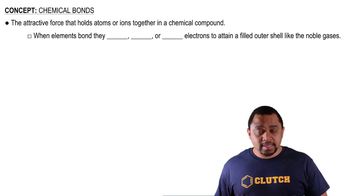Here are the essential concepts you must grasp in order to answer the question correctly.
Ionic vs. Molecular Compounds
Ionic compounds are formed from the electrostatic attraction between positively and negatively charged ions, typically involving metals and nonmetals. In contrast, molecular compounds consist of molecules formed by covalent bonds, where atoms share electrons, usually involving nonmetals. Understanding the distinction helps in predicting properties such as melting points, solubility, and electrical conductivity.
Recommended video:
Chemical Bonding
Chemical bonding refers to the forces that hold atoms together in a compound. Ionic bonds occur when electrons are transferred from one atom to another, resulting in charged ions. Molecular compounds are held together by covalent bonds, where electrons are shared between atoms. Recognizing these bonding types is essential for classifying compounds correctly.
Recommended video:
Nomenclature of Compounds
Nomenclature is the system of naming chemical compounds based on their composition and structure. Ionic compounds are typically named by combining the names of the constituent ions, while molecular compounds use prefixes to indicate the number of atoms present. Familiarity with nomenclature rules aids in identifying and categorizing compounds like N2O4, which is molecular due to its covalent bonds.
Recommended video:
 Verified step by step guidance
Verified step by step guidance


